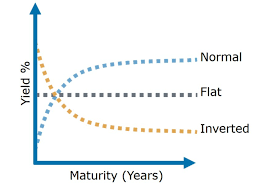
How to Invest When the Yield Curve is Inverted
How to Invest When the Yield Curve is Inverted
By J.R. Robinson, Financial Planner (September 4, 2022)
As of this writing, 90-day T-bills are yielding around 5.4% while the 10-year Treasury sits at around 4.8%. Historically, inverted yield curves like this have been both rare and ephemeral. Intuitively, it makes little sense for investors to get paid less to tie up their savings for longer periods of time.
How Long with The Yield Curve Stay Inverted?
A common explanation and prediction for the current inverted yield curve is that short term rates reflect current high inflation, but long-term rates remain low because most investors expect inflation to return to the Fed’s target normal rate of around 2%. Indeed, the Fed’s aggressive series of hikes provides support for that belief. As the rhetoric goes, once inflation is contained, the Fed will then need to reduce short term rates to help restart the economy and the yield curve will then flatten and eventually return to normal shape.
However, an alternative outcome that does not receive as much attention is that inflation may prove more stubborn than anticipated. As investors come to consider that rates may not be coming down anytime soon they may begin to demand higher yields for tying their money up for longer time periods. In the past few weeks we have seen evidence of this in the form of modest spikes in the 10 and 30 year treasury yields.
Of course, no one knows how long the current rate phenomenon will last or how will end or which of these alternative scenarios comes to fruition. However, with yields in the 5%+ range, I continue encourage clients to gobble up CDs and treasuries and to spread maturities out as far as 3 years if we can get close to 5% yields to maturity on the long end. If rates continue to creep up on the longer side and we see yields close to 5% in the 4-6 year range, I will encourage investors to spread their ladders longer.
What about bond funds? – The Answer is still, “NO”
I have read a bunch of articles over the past couple of months advising investors to invest in longer term bond funds. The authors of these articles subscribe to the first yield curve reversion prediction described above. They expect the Fed will soon move to cut rates and that even long term rates will fall. They suggest that now may be a wonderful opportunity to make up for the losses bond fund holders endured as rates rose from January 2022 until now.
In my opinion, this is a foolish play, as it completely discounts the alternate scenario. If inflation persists, those same bond fund holders who got burned in 2022 will get burned again as the reversion to the normal yield curve shape is fueled by rising long term rates. My advice is the same as always – friends don’t let friends buy bond funds. The laddering strategy outlined above will typically capture most of the yield at the highest point of the yield curve and enables investors to avoid negative nominal returns by holding to maturity.
John H. Robinson is the owner/founder of Financial Planning Hawaii and Fee-Only Planning Hawaii. He is also a co-founder of fintech software-maker Nest Egg Guru.

